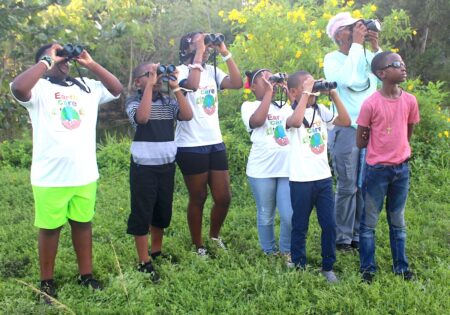
Every year thousands of migratory birds make epic journeys south. Many stop over in the Caribbean to rest and refuel; others arrive and spend the entire winter with us. Throughout Fall 2023 and on World Migratory Bird Day, we celebrated these beautiful visitors. We recognized and highlighted the amazing ways in which they adapt to endure such lengthy and dangerous journeys, and called attention to the importance of water to the survival of these birds. Check out the fun and creative ways in which Caribbean organizations got involved. Laura Baboolal, Caribbean Coordinator of World Migratory Bird Day for Environment for the Americas (EFTA), tells the story…
Water conservation for migratory birds and people
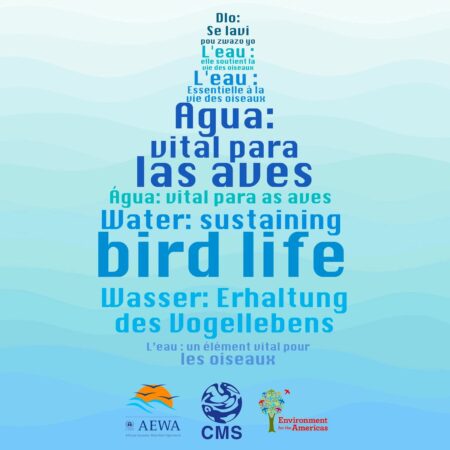 Every year we eagerly await the arrival of migratory birds as they flock to our shores, wetlands, forests, parks, gardens, and even backyards! This year’s theme was “Water: Sustaining Bird Life”; “Agua: vital para las aves” in Spanish; and in French, “L’eau: Source de vie pour les oiseaux.”
Every year we eagerly await the arrival of migratory birds as they flock to our shores, wetlands, forests, parks, gardens, and even backyards! This year’s theme was “Water: Sustaining Bird Life”; “Agua: vital para las aves” in Spanish; and in French, “L’eau: Source de vie pour les oiseaux.”
Birds need water as much as we do! They need to drink water to help them regulate body processes and use water to keep themselves clean and cool. And many migratory birds depend on healthy wetland habitats such as ponds, marshes, mangroves, rivers and coastal areas to safely rest during their long journeys south and to feed and replenish their energy.
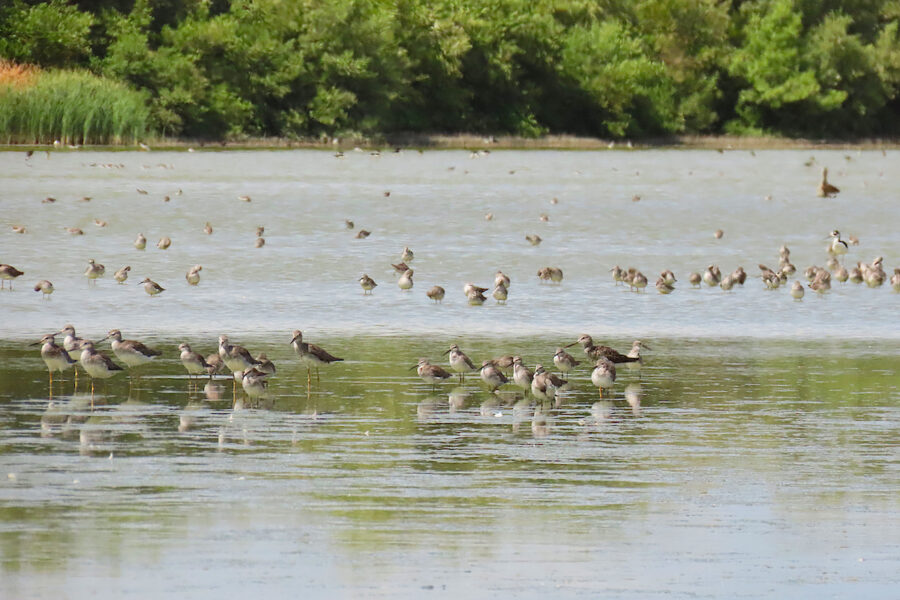
This year’s theme highlighted the the impact of the growing water crisis on migratory birds. This theme resonated in the Caribbean, where islands have been enduring longer-lasting and more severe droughts. It is not only farmers and householders who are feeling the effects of lower than normal rainfall patterns. Birds are, too! Drought causes wetland habitats such as ponds, salinas, marshes, and rivers to shrink and dry up, thus impacting the amount of water available for birds to drink, feed and bathe, particularly those that rely on wetland habitats. Water scarcity also impacts people— we need clean water to drink, bathe, and grow our food.
The good news is that there are easy, everyday ways for us to reduce our water use and keep our natural supply of water flowing. Find out how our dedicated and passionate Caribbean educators throughout the islands used WMBD events to build and support coalitions of people to advocate for the protection of critical wetland habitats and water conservation.
Here are some highlights from this year’s WMBD events held in The Bahamas, Jamaica, Cuba, Dominican Republic, Puerto Rico, St. Martin, Sint Maarten, Antigua and Barbuda, Guadeloupe and Trinidad and Tobago. Many more islands are still hosting events, activities and celebrating this special time for migratory birds!
The Bahamas
EARTHCARE, an environmental education NGO that works across the islands of The Bahamas, celebrated WMBD by hosting a birdwatching trip for children at Princess Park on Grand Bahama Island. The children were excited to see and learn about the different birds at the Park. For many it was their first time using binoculars (provided by EFTA) and they were eager to find the birds using this fundamental tool for birders. Children love using binoculars and the first time using them is always a revelation! Gail Woon and Jill Cooper (EARTHCARE representatives) also visited the Eco School at Bishop Michael Eldon School (BMES) and made a presentation on the importance of water to birds, with special emphasis on migratory birds, and people.
Jamaica
The Natural History Museum of Jamaica moved its popular “An Afternoon with a Scientist” from online and into nature at Hope Botanical Gardens, with the esteemed speaker being Ricardo Miller. Ricardo is a longtime member of BirdsCaribbean, veteran Jamaican birder, and Environmental Coordinator at the National Environment and Planning Agency (NEPA). Following this talk, students of Mona Preparatory School, Rollington Town Primary School and Sts. Peter and Paul Preparatory School in Kingston were treated to a birdwatching trip across the Gardens. Out in the field the youngsters had great fun using binoculars and bird ID cards to find and identify any birds they could spot!
The session was a collaborative effort among the Hope Botanical Gardens, NEPA and Jamaica Environment Trust to commemorate this year’s World Migratory Day under the theme “Water and its Importance for Migratory Birds”.
Cuba
In Cuba, Biblioteca Municipal de Bauta (Bauta Municipal Library) in collaboration with the Bauta Birdwatchers Club, Faculty of Geography and Bird Ecology Group (University of Havana) hosted a migratory bird watching activity with 4th and 5th grade school students. The children learned about bird identification and the importance of protecting birds in their country.
Dominican Republic
During the month of October, Grupo Acción Ecológica (GAE) (Ecological Action Group) carried out several activities to celebrate migratory birds. The group ventured to different birding spots in the Dominican Republic to carry out bird counts, and uploaded their birding checklists to the eBird Caribbean online database.
GAE also partnered with the Department of Education to assist students with planting trees at the National Botanical Garden, thus increasing the number of endemic plants at the Garden. These plants will no doubt provide shelter and food for birds, and other wildlife for many years to come! The man-made lagoons at the Garden were the perfect setting for a live demonstration of the importance of water to birds.
In Jarabacoa the hands-on approach to learning, birding, and conservation continued. Students of the Doulos School went on bird walks and learned about different methods to survey bird abundance and species diversity. They also drew and painted the birds they saw and submitted their artwork to a WMBD contest organized by GAE. The festivities ended in the Colonial Zone of Santo Domingo with a talk, tree planting activity, and birdwatching, where they had the opportunity to see more migratory birds!
Lecturer at Universidad Autónoma de Santo Domingo (Autonomous University of Santo Domingo), and long-time member of BirdsCaribbean, Simón Guerrero, introduced primary school students to migratory birds through a riveting presentation on common migrants. They learned about ‘Moonbird,’ a male Red Knot celebrated for its epic 10,000 mile annual migrations and for being the oldest known member of its species! Simón told us, “I always plant some trees to be sure birds will know we are doing something real for them, not just talking.” After the presentation and WMBD activities, firebush or hummingbird bush (Hamelia patens), a plant whose flowers and fruits are very attractive to native, endemic, and some migratory birds, was planted on the school’s compound.
Puerto Rico
Conservation Opportunity got their hands dirty to help migratory birds! The NGO celebrated World Migratory Bird Day by cleaning the waterways in Charco Dos Bocas, Ciales, Puerto Rico. Approximately 150 pounds of trash were collected in one day. Over 50 people showed up to lend a hand and learn about birds. They also installed a new sign, reminding their fellow Puerto Ricans and visitors to the river to keep the environment clean.
Meanwhile, Sociedad Ornitológica Puertorriqueña Inc. (SOPI) headed to EcoExploratorio (Science Museum of Puerto Rico) to talk about water conservation for birds and how to identify some of the more common winter migrants on the island.
St. Martin / Sint Maarten
This year Laura was able to visit St. Martin to attend a WMBD event hosted by Les Fruits de Mer and to share educational materials with both Les Fruits de Mer and Nature Foundation Sint Maarten.
This Migratory Bird Festival included art activities for children, educational activity books developed by the organization, and nature walks.
Guadeloupe
Our partner, outstanding guide, and skilled biologist Anthony Levesque gave a talk on the on the birds of La Désirade. It is one of the islands of Guadeloupe and is better known for its white sand beaches and coral reef. It is also a sanctuary for birds looking to rest and refuel during migration. The following day Anthony led a birdwatching tour with 20 participants, who recorded some notable species such as the Greater Yellowlegs, Lesser Yellowlegs, Rose-breasted Grosbeak, and Bobolink.
Trinidad and Tobago
WMBD was celebrated in May on the same day as Global Big Day and the Caribbean Endemic Bird Festival (CEBF), at the ARC Conservation Field Station in Brasso Seco in Trinidad. You can read about the “Protect the Rivers, Save the Birds” event in our CEBF wrap-up blog.
In October, local school teacher Sabira Ali, who hosts private birding activities for children, celebrated WMBD with her students. The activity included a presentation on migratory birds—by the students themselves! Students were asked to select a migratory bird and give a short presentation on the bird to their classmates. This was followed by decorating bird masks and a fun quiz to recap all the feathery facts learned.
We applaud the tremendous efforts of our educators who plan and execute educational and fun activities to ensure an unforgettable WMBD and inspire a love for birds and birdwatching. We extend a massive thank you to our ambassadors, who selflessly deliver educational materials to Caribbean islands. Environment for the Americas and BirdsCaribbean extend our greatest thanks to all of you and we look forward to seeing what you have planned for WMBD 2024!
Birds Connect our World—Fifteen new species shared on BirdsCaribbean’s website
BirdsCaribbean recognized WMBD by featuring new migratory birds in our virtual campaign– Birds Connect Our World. Each migratory bird profile was accompanied by a beautifully drawn coloring page by Christine Elder, stunning high quality photos and videos, online puzzles tailored for different levels (between six and 1,024 pieces), and bird calls. Fun, free and engaging activities were also provided for both kids and adults, including downloadable coloring pages, experiments, up-cycle crafts, and more. We also created short videos to help birders identify shorebirds that show up every fall in the Caribbean—for example, the Least Sandpiper, Lesser Yellowlegs, Short-billed Dowitcher and Stilt Sandpiper, Black-bellied and American Golden Plovers and the small and adorable, but confusing, plovers too!
Flying, hopping, wiggling, and crawling towards WMBD 2024
The WMBD theme for 2024 is Insects! While some people may shriek at the sight of these tiny creatures (and rightfully so because our brains confuse fear with disgust, and some insects are actually harmful to us) they are an important delicacy for birds. In fact, insects are so important to birds that migratory birds will literally fly halfway around the globe just to have an ample supply of insects to eat! Insects and bugs are a high protein food. Protein is essential to birds for keeping up energy and body mass and for growing baby birds.
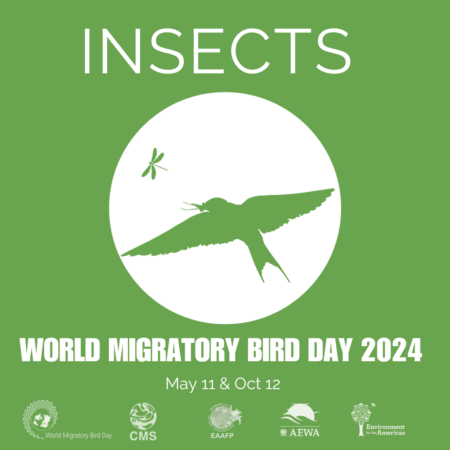 A study published in the Journal of Biological Conservation reported that 40% of all insect species are declining globally. Loss of natural areas like forests and grasslands that have been converted or degraded by intensive agriculture and urban development, and climate change, have all contributed to this downward population trend. A scarcity of this protein-rich food source can hinder bird migration and breeding, leading to weakened immune systems, reduced reproductive success, and increased mortality rates for both adult birds and their offspring.
A study published in the Journal of Biological Conservation reported that 40% of all insect species are declining globally. Loss of natural areas like forests and grasslands that have been converted or degraded by intensive agriculture and urban development, and climate change, have all contributed to this downward population trend. A scarcity of this protein-rich food source can hinder bird migration and breeding, leading to weakened immune systems, reduced reproductive success, and increased mortality rates for both adult birds and their offspring.
The WMBD campaign in 2024 will thus stress the need for proactive conservation measures like reducing the use of pesticides and fertilizers, switching to organic farming, and maintaining and connecting areas of natural vegetation in agricultural landscapes.
If you are interested in celebrating WMBD in your country, or if you can deliver materials to a Caribbean country, we encourage you to visit the WMBD website for more information; or contact the Caribbean Regional Coordinator, Laura Baboolal, at lbaboolal@environmentamericas.org. If you have an event planned, you can register it and put the Caribbean on the global events map.

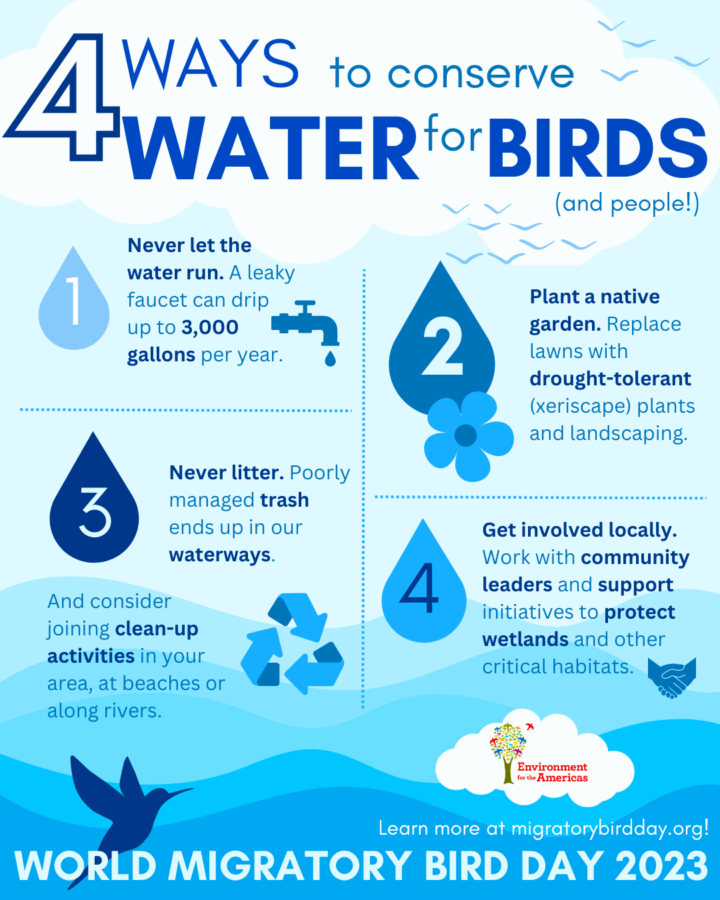












































One comment
Comments are closed.